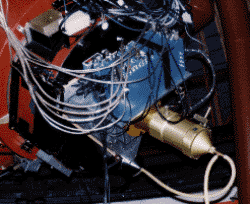K-Cam III
Kcam III is a near infrared camera system dedicated to the astronomical "K" band from 2.0 to 2.4 microns. The detector in this camera is the NICMOS3 mercury-cadmium-telluride (HgCdTe) array from Rockwell International Science Center (Thousand Oaks, Ca.) which has 256 x 256 pixels each 40 microns square. Originally commissioned on the University of California Observatories (UCO) 1-m Nickel Telescope on Mt. Hamilton, KCam III was then used on the 24-inch telescope at UCLA together with a Photometrics Star 1 camera system (with BVRI filters) and a dichroic beamsplitter to enable optical and IR bands to be observed simultaneously. The image scale is 0.85 arcseconds/pixel. First Light was obtained in March 1992. Current applications include the following: student teaching projects, monitoring variable stars, monitoring the optical/IR variations of active galaxies, photometry of T Tauri stars too bright for larger telescopes, observations of Io during eclipses by Jupiter's shadow. K-CAM III is now retired.
Reference: "Infrared Astronomy with Arrays: The Next Generation", I.S. McLean, editor, Kluuwer Academic Publ., Netherlands.
Detector (NICMOS III HgCdTe Array):
- Format: 256x256 pixels
- Pixel Size: 40 microns
- Full Well: 240,000 e- with a reverse bias of 0.6V
- Dark Current: 1 e-/sec/pix at 77K
- Read Noise: 47e-, correlated double sampling, and 26e-, multiple sampling with 4 reads.
- Q.E.: 60% at 2 microns
Camera at Lick 1-m Telescope
- Optics: 1:1 ZnSe re-imaging lens that provides a cold stop
- Plate Scale: 0.48 arcsec/pixel
- Field of View: 2' x 2'
- Filter: K' (1.95 - 2.35 microns)
- Gain: 15 e-/ADU
- Background: 750 e-/sec/pixel
- Sensitivity: K=17.3, 6 sigma, 45 min for point sources
- Photometry: 2% for point sources

